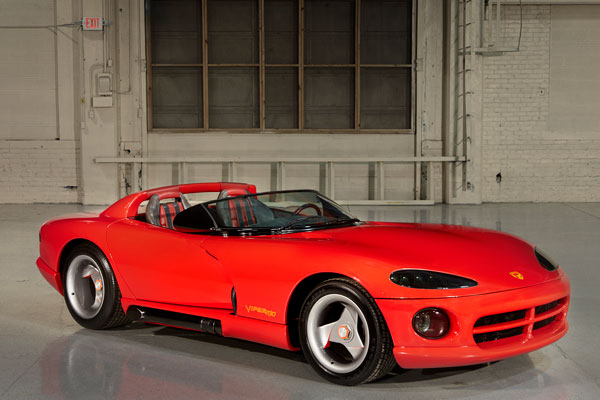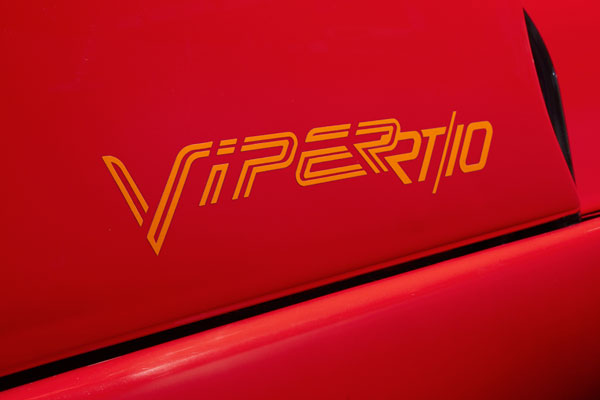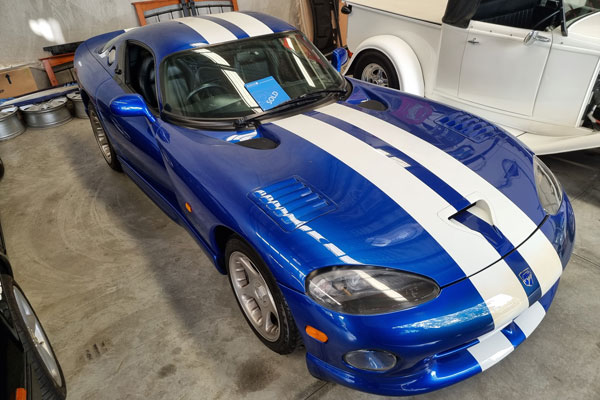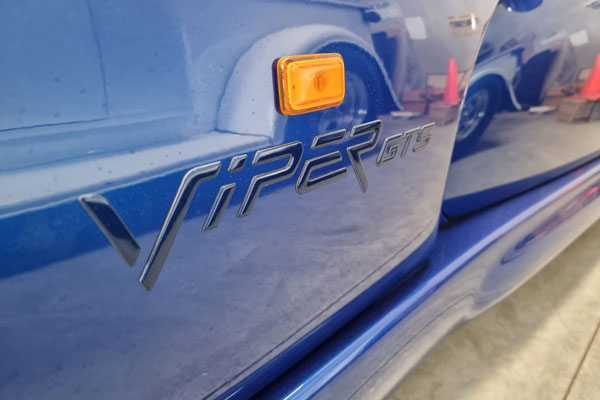Classic Supercar: Dodge Viper RT/10 Concept
In 1989, Dodge, the venerable automotive brand that has been a division of Chrysler (now Stellantis) for nearly 100 years, revealed the concept model of what would become its halo supercar/muscle car – the Viper.
The car’s first appearance was at the 1989 North American International Auto Show in Detroit, and Dodge’s goal was to see what the public would make of a concept that, in its early form, had a 5.9-litre V8 under the bonnet, and which, with its aggressive appearance, was clearly designed to be a brutally powerful and quick sports car.
Not surprisingly, the two-seater, rear-wheel-drive Viper, built on a tubular frame with a fibreglass-panel body, was met with plenty of enthusiasm and the decision was swiftly made by the carmaker’s head honchos to see if the crowd-pleasing show car could be put into limited production in as short a time as possible.
A team was assembled, known as Team Viper, and some performance benchmarks were struck – most notable being the car be capable of 0-100-0mph (0-161-0km/h) in less than 15 seconds.
It took a little while for the Viper to appear in its production guise, but after testing more prototypes, a pre-production Viper RT/10 made its debut as the pace car at the 1991 Indianapolis 500 race.
By this time, the V8 had been replaced by a monster 8-litre V10 that had been developed with input from Lamborghini
– a subsidiary of Chrysler at the time. Power came in at 300kW and 630Nm. Top speed was over 250km/h and 0-100km/h was reached in around 4.3 seconds.
It was quick.
While the Italian supercar maestros may have had some input into the engine, there was no denying the all-American aura of the Viper. It looked low, wide, and mean; had huge tyres and wheels; and the massive engine up front meant a massively long bonnet. Like its rival of the period, the Chevy Corvette, it had the feel of a supercar/muscle car hybrid.
The first Viper RT/10 production cars rolled off the assembly line in December of 1991 and the Viper design team’s desire for a car that was just about speed and power was obvious.
Inspiration had come from the Shelby Cobra cars of the 1960s, and the comparisons went beyond just the serpent-like names. They were light, powerful and the point was about delivering an adrenaline-fuelled driving experience – to go fast and not have anything get between the driver and their complete engagement with the car.
And so the first-generation Viper came without stability control, traction control, or ABS. There were no airbags, no side windows (though some fairly rugged vinyl ones could be stuck into slots into the door frame if required), no air-conditioning or exterior door handles or roof (a canvas one could be fitted), and entertainment came courtesy of a basic Chrysler generic radio – no upmarket entertainment system here.
The Viper was well received, and nearly 7000 were built across the first generation’s production life of 1992-1996.
However, 1996 saw the Viper get some upgrades, and saw the release of the GTS model. This car was an attempt by Dodge to create a car in ‘the mold of the world’s premier Grand Touring cars.’
While the GTS and the RT/10 look similar, more than 90 per cent of the Coupe was new and built with an eye on saving weight, and even with creature comforts such as air-conditioning, exterior door handles, power glass side windows, and a roof (which was an odd double-bubble shape to allow drivers wearing racing helmets to fit snuggly inside) added so as to appeal to its new target market, the GTS weighed in at 45kg less than the earlier model.
Other changes included an all-aluminium suspension system and re-engineered frame, while 36kg were removed from the cooling system and engine. That engine had a bump in power and now pumped out 336kW and 664Nm. That power continued to be routed through a six-speed manual transmission.
It was the GTS model that Chrysler/Dodge took and, with French motorsport team Oreca and UK racing car manufacturer Reynard, modified into the Viper GTS-R. It was a phenomenally successful car, winning championships across Europe, and scoring class wins at Le Mans in 1998, 1999 and 2000.
In 2003, a third-generation Viper appeared with new body styling and boasting an upgraded 8.3-litre engine punching out 373kW. 0-100km/h was now reached in under four seconds and top speed was 305km/h.
A fourth generation arrived in 2008 with more styling tweaks and a beefed up 8.4-litre engine. With 447kWkW now available, top speed was up to 325km/h and the 0-100km/h sprint was achievable in 3.5 seconds.
This fourth generation lasted only for a couple of years when, in 2010, production came to a halt and the Viper was put on hold and did not appear again until 2013.
This fifth-generation model came with even more power and a bunch of improved comfort features including a top-notch sound system, touch-screen interaction and many of the features associated with a luxury performance car. By 2017, the Viper has an all-aluminium 8.4-litre V-10 engine that delivered 481kW and 813Nm. Standard safety features include electronic multi-stage stability control, traction control and a new anti-lock brake system.
While the Viper was undoubtedly a cracking piece of work and a solid number of about 31,000 (including many special-edition variants) were sold over its 25-year production lifetime, Dodge/Chrysler (or FCA as it was from 2014), decided to halt building them in 2017, and one has to wonder if such a car – that would now come under the Stellantis company umbrella and have to be approved for production in an environment focused on electrification – may ever make a comeback. It would be nice to think it could.
Rare Viper Departs Australia for Hong Kong
This magnificent-looking blue and white Viper is a 1996 GTS model – generally considered by enthusiasts as the best of the Viper’s many variations.
For years, thsi Viper called Brisbane home, but it recently made the trip to Hong Kong and into the hands of a new owner, stopping briefly at the Supamerc dealership owned by Peter Dever.
Peter, who is also Chairman of MTA Queensland’s Automotive Remarketing Division, has a long history of doing business in Hong Kong, and it was a client there who got him involved in the export process for this car.
“He asked me to investigate the vehicle after he became aware it had come up for sale,” said Peter. “So, I went and had a look at it, reported back to him on its pedigree, and then negotiated what I believed was a fair price.”
The pedigree of this particular car is actually pretty outstanding. There are only a handful of Vipers in Australia, and this stands out even amongst that small group. The reason for that, said Peter, is that when it was imported, it was the first Viper to go through the wringer of regulations and modifications required by the Australian Government for an imported car to be converted to right-hand drive and meet national safety standards.
As the first to go through that process, the GTS was the benchmark vehicle for that procedure. And the upshot of being first, is that maximum effort and focus was put in to make sure the modifications were top-notch quality – a fact not lost on Peter or his Hong Kong-based client.
“Because it was the test and evaluation vehicle, we knew that the conversion workmanship was perfect,” said Peter. “Evaluation vehicles are subject to immense scrutiny to get approval. Engineers have to sign off on it, it has to do emissions testing and all sorts of other scenarios before that approval is given.
“On top of that, this car has very low mileage. The guy who originally commissioned it was quite a tall gentleman and he struggled to fit into it properly, so he only kept it for a short time before selling it to a dealer here in Brisbane. That dealer subsequently sold it on to the last owner who kept it for 14 years and clocked only 2000km. Right now, the car is showing about 11,000km, which is the total it has done since it was converted. It is very special.”
Source: Motor Trader e-Magazine (June 2021)
1 July 2021













 A fantastic turnout in Townsville for the final leg of our regional tour
A fantastic turnout in Townsville for the final leg of our regional tour